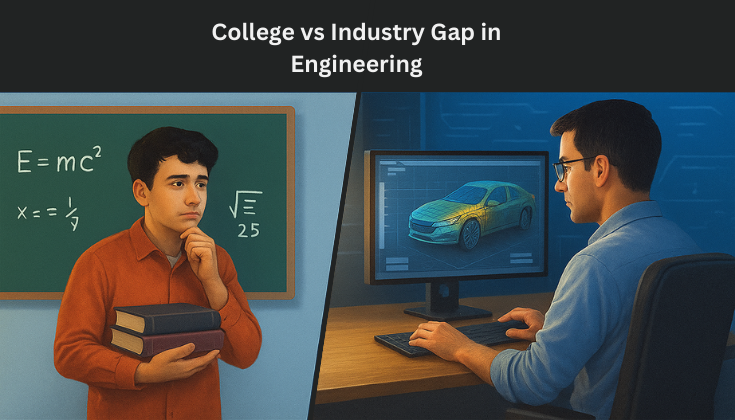

“Degrees may get you the interview. Real tools get you the job.”
Every year, thousands of engineering graduates step out of Indian universities with a mechanical, civil, electrical, or electronics degree. They know equations, definitions, and maybe a few software tools like AutoCAD or SolidWorks.
But when they walk into the real world of product design, testing, and innovation, they hit a wall.
Why? Because what colleges teach and what the industry expects are miles apart — especially in CAE (Computer-Aided Engineering).
The Harsh Reality: A Huge Skill Gap
Walk into any OEM, R&D center, or engineering services company, and you’ll hear the same thing:
“We need engineers who can hit the ground running.”
“Freshers lack hands-on knowledge of simulation tools.”
“They know CAD, but not how to validate or simulate.”
In short: students are not job-ready. And it’s not their fault — because the academic system is still stuck in outdated syllabi and chalkboard teaching.
Why CAE Tools Are Now Mandatory
Today, design is incomplete without simulation.
In every sector — automotive, aerospace, defence, manufacturing, railways, energy, biomedical — products are no longer just drawn and manufactured. They are simulated, tested virtually, optimized, and then built.
CAE tools help engineers:
✅ Predict failures before they happen
✅ Improve product safety and performance
✅ Optimize weight, cost, and life span
✅ Meet global regulatory standards (NCAP, ASTM, IS, ISO)
✅ Reduce prototyping and testing costs
So if you’re not simulation-literate, you’re not industry-ready.
What Colleges Teach vs What Industry Uses
Here’s a real comparison:
| In College | In Industry |
| AutoCAD / SolidWorks basics | HyperMesh for meshing complex assemblies |
| Stress/strain theory on paper | LS-DYNA or Abaqus for crash and durability |
| 2D beam analysis manually | ANSYS Mechanical for structural analysis |
| Theory of vibration | Nastran for NVH simulation |
| Manual fatigue calculations | nCode or fe-safe for fatigue life prediction |
| Heat transfer numericals | Ansys Fluent or Star CCM+ for thermal/CFD |
| Lab testing | Digital Twin & AI-integrated CAE workflows |
The gap is obvious — and the only way to bridge it is through CAE upskilling.
Must-Know Real-World CAE Tools for Modern Engineers
Here are the tools we teach at ELENO COE, and that real R&D teams use daily:
🔧 1. LS-DYNA
For: Crashworthiness, Impact, Blast Simulation
Used in: Automotive, Defence, Railways
🧠 2. Abaqus
For: Non-linear static/dynamic simulation, Durability
Used in: Aerospace, Automotive, Consumer goods
🔊 3. Nastran + Actran
For: NVH (Noise, Vibration, Harshness) Analysis
Used in: Vehicles, Electronics, White goods
🌀 4. Ansys Fluent / Star-CCM+
For: Fluid flow, Thermal, HVAC, Aerodynamics
Used in: EV Cooling, Aerospace, Energy
For: Preprocessing, Meshing, Model Setup
Used in: All simulation industries
💥 6. nCode / fe-safe
For: Fatigue and Life Prediction
Used in: Railways, Heavy vehicles, Engines
🤖 7. MATLAB & Python for CAE
For: Automation, AI-assisted simulation, Data post-processing
If you’re aiming to work in core engineering, knowing at least 2–3 of these tools is critical.
Why Colleges Still Lag Behind
- Outdated curriculum: Many universities haven’t revised their syllabus in over 10 years.
- Lack of hardware/software: Simulation tools need high-end systems and licenses.
- Limited industry exposure: Professors often haven’t worked in actual CAE roles.
- Focus on theory over application: Simulation isn’t just about numbers — it’s about understanding behavior.
At ELENO COE, we fix all of these with industry-mentored training, live projects, and tool-based learning.
What You Can Do as a Student
🔹 Start early – Don’t wait for final year. Begin learning simulation in 2nd or 3rd year.
🔹 Join industry courses – Learn from professionals who work in R&D.
🔹 Work on projects – Apply what you learn in real design/simulation problems.
🔹 Ask questions beyond syllabus – Learn about load cases, standards, boundary conditions.
🔹 Practice, don’t just watch – Simulation is a skill. You learn by doing.
Message for Parents and Colleges
Parents: Support your child if they want to learn simulation tools. It’s not a distraction — it’s an investment. These tools can create careers that are global, technical, and impactful.
Colleges: Collaborate with centers like ELENO COE to introduce real CAE labs and simulation-focused electives. This is the need of the hour.
Final Words: Simulation Is Not Optional Anymore
The next generation of engineers will not just design components — they will predict failures, optimize performance, and save lives through CAE.
If you want to build a career that survives industry automation, global competition, and AI integration, mastering CAE tools is the way forward.
Let’s bridge the college-to-industry gap, one simulation at a time.
📞 Contact Nachiket: 9881732144
🌐 Visit: www.eleno-elc.com
#RealEngineering #CAEForCareers #SimulationTools #BeyondCollegeSyllabus #ELENOCOE #MechanicalSimulation #CrashDurabilityNVH #EngineeringSkillsThatMatter #MadeInIndia #EngineeringEducationReform


